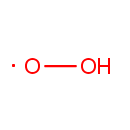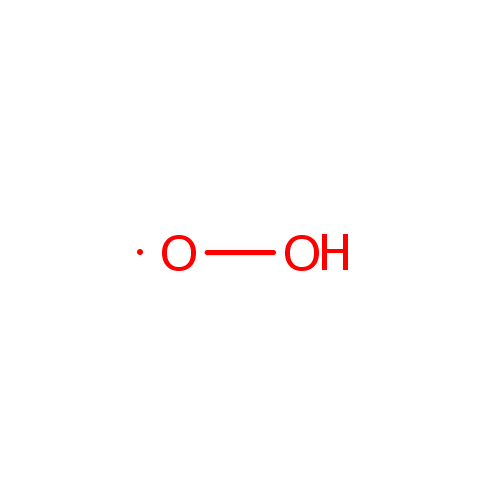|
Record Information |
|---|
| Version |
1.0 |
|---|
| Update Date |
1/22/2018 11:54:54 AM |
|---|
|
Metabolite ID | PAMDB003391 |
|---|
|
Identification |
|---|
| Name: |
superoxide |
|---|
| Description: | Highly reactive compounds produced when oxygen is reduced by a single electron. In biological systems, they may be generated during the normal catalytic function of a number of enzymes and during the oxidation of hemoglobin to METHEMOGLOBIN. In living organisms, SUPEROXIDE DISMUTASE protects the cell from the deleterious effects of superoxides. |
|---|
|
Structure |
|
|---|
| Synonyms: | - (HO2)(.)
- Dioxidanyl
- HO2(.)
- Hydrogen dioxide
- Hydroperoxo
- Hydroperoxy radical
- Perhydroxyl radical
- Peroxyl radical
|
|---|
|
Chemical Formula: |
HO2 |
|---|
| Average Molecular Weight: |
33.0067 |
|---|
| Monoisotopic Molecular
Weight: |
32.997654276 |
|---|
| InChI Key: |
OUUQCZGPVNCOIJ-UHFFFAOYSA-N |
|---|
| InChI: | InChI=1S/HO2/c1-2/h1H |
|---|
| CAS
number: |
11062-77-4 |
|---|
| IUPAC Name: | dioxidanyl |
|---|
|
Traditional IUPAC Name: |
peroxyl radical |
|---|
| SMILES: | [O]O |
|---|
|
Chemical Taxonomy |
|---|
|
Taxonomy Description | This compound belongs to the class of inorganic compounds known as homogeneous other non-metal compounds. These are inorganic non-metallic compounds in which the largest atom belongs to the class of 'other nonmetals'. |
|---|
|
Kingdom |
Inorganic compounds |
|---|
| Super Class | Homogeneous non-metal compounds |
|---|
|
Class |
Homogeneous other non-metal compounds |
|---|
| Sub Class | Not Available |
|---|
|
Direct Parent |
Homogeneous other non-metal compounds |
|---|
| Alternative Parents |
Not Available |
|---|
| Substituents |
- Homogeneous other non metal
- Acyclic compound
|
|---|
| Molecular Framework |
Acyclic compounds |
|---|
| External Descriptors |
|
|---|
|
Physical Properties |
|---|
| State: |
Solid |
|---|
| Charge: | -1 |
|---|
|
Melting point: |
Not Available |
|---|
| Experimental Properties: |
|
|---|
| Predicted Properties |
|
|---|
|
Biological Properties |
|---|
| Cellular Locations: |
Cytoplasm |
|---|
| Reactions: | |
|---|
|
Pathways: |
Not Available |
|---|
|
Spectra |
|---|
| Spectra: |
|
|---|
|
References |
|---|
| References: |
Not Available |
|---|
| Synthesis Reference: |
Not Available |
|---|
| Material Safety Data Sheet (MSDS) |
Not Available |
|---|
|
Links |
|---|
| External Links: |
|
|---|


